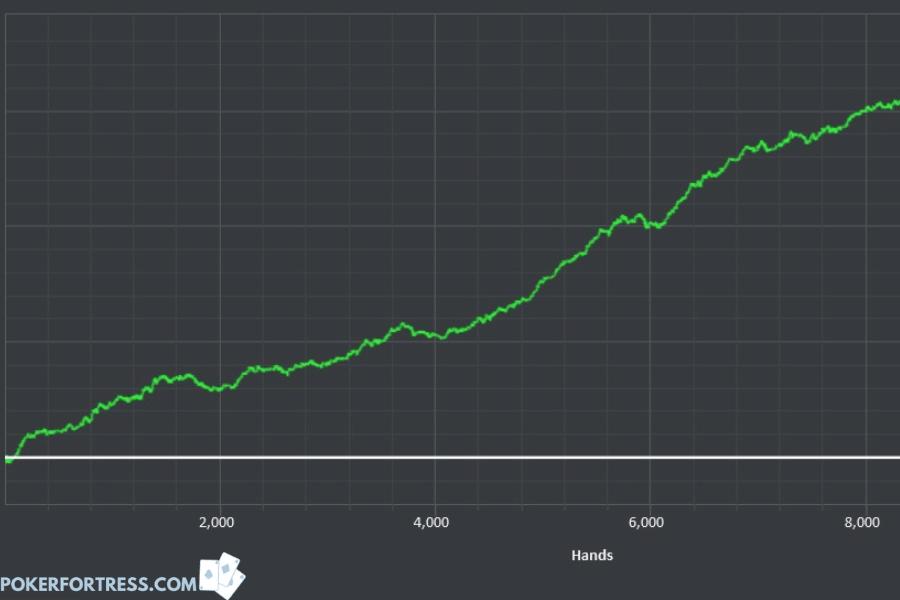One of the catalysts for the poker boom is the massive earning potential. The idea of making millions playing a card game thrilled millions of enthusiasts worldwide. But do poker players really make the amount of money that we think, or perhaps, being a professional player isn’t as rewarding as we think?
The money that poker players make varies depending on several factors. Someone who plays longer doesn’t necessarily mean he earns more money. A heavy grinder who plays micro-stakes games, full-time, can make anywhere from $8,000 to $46,500 per year, and professional players on mid to high stakes can make mid 6 figures per year.
On the other hand, live players can earn thousands overnight. This amount doesn’t include tournament participation that can have a massive impact on their income. We’ll discuss everything about a poker player’s earning potential in great detail. Stick around to find out whether turning pro will be the right choice for you.
If you want to be a professional online poker player, then being a member of a poker training site is a must to keep improving. Here is a list of best poker training sites.

Professional vs. Amateurs: How Do They Compare
Playing as an amateur or a professional has a significant impact on the amount of money you can make. Amateurs make money from playing poker, but it’s not their primary income. They only play for a few hours and only when they have time. On the other hand, professional players only make money from playing poker ( and in rare occasions getting sponsored to play). It’s their business, and the money they make depends on the time they allot for playing.
From this simple comparison, you’ll know that professionals will make significantly more money from poker than other players. But let’s assume that you’re an amateur who’s thinking about going professional. Maybe you’re already turning some profit playing casually, and you’re thinking that playing full-time can replace your primary income, right?
The answer isn’t as simple as you think because professional poker heavily relies on your ability to produce consistent results. A great way to get more consistent results is to have a great rakeback deal.
When playing part-time, you might get a few lucky hands here and there. But when you start playing professionally, luck becomes so insignificant that we can’t use it to determine how much you’d make. At that point, you start to understand that skill has a much greater role in poker than luck.
How Much Can You Make in Micro Stakes Tables?
The money you’ll make every month highly depends on the stakes you’re playing. Of course, someone who plays consistently at $1/2 will make significantly more than someone who plays NL2. However, the calculation for it isn’t as simple as what many people think.
NL2 is the most common casual game that we play because it is the lowest stake table. So, we’re assuming that it’s your preferred table, and you’re making $200 a month. It doesn’t mean that your profits will be linear, that you’d make $5,000 a month if you start playing NL50.
In fact, most poker players wouldn’t even reach a win rate of 6 big blinds per 100 games at NL50, while an NL2 grinder would, most likely, get a win rate close to 30 big blinds per 100 hands.
Aside from that, the number of hands you play per hour would also determine how much money you make.
If you’re only playing 400 tables per hour, it would only make sense that you’re making less than someone who can play 800 tables per hour.
Setting Your Expected Rate of Play
To start our calculation, let’s assume that you’re someone who can play 8 tables simultaneously for 8 hours a day, 5 days a week, and 52 weeks a year. In a 9-handed table, you can expect to play about 65 hands per table per hour. For 6max this number would go up by about 20-30%
- 65 hands x 8 tables = 520 hands per hour
- 520 hands x 8 hours = 4,160 hands per day
This computation is only a rough estimate, and you don’t have to play for 8 hours daily if you can play more tables. Those who can multi-table 12 tables only need to play for 6 hours a day and still get around 4,680 hands per day.
Remember, as a professional player, the number of games and your consistency in playing these games will determine your income. So, let’s say that you can keep playing for 25 days a month, which gives you enough time to rest for a full day every week.
- 4,160 x 25 days = 104,000 hands per month
Playing 104,000 hands every month seems a lot, right? But how do we convert these hands into something that can pay the bills? Remember, as a professional, your only income is to play poker. So converting these hands into cash is the most crucial part.
Before we proceed with the calculation, here’s a quick disclaimer: most players who are playing poker lose money. We’d say anywhere around 75% to 80% won’t make anything, other than the occasional big pot wins, which often comes right after losing all of their chips, meaning it never happens to most of the players.
However, there are also some players, around 10% of those who play a lot of hands, who can really make a living from poker.
So, we’re going to assume that you belong in the top 10% of the world’s best poker players, which, by the way, sums up to millions of active players.
Heavy Grinder’s Income at NL2
NL2 is the lowest stake poker, with blinds at 1c/2c and a max buy-in of $2. Since you’re only planning to move from being an amateur to professional, we’d recommend that you start here because it has the lowest risk. But will your earnings from NL2 be enough to pay for all of your bills?
Let’s say that your win rate for NL2 remains consistent at 30 big blinds for every 100 games. Each blind is 2c, which we’ll use to calculate the money you can make from playing 104,000 hands per month.

- 30 x 2 = 60 cents for every 100 hands you play.
- 104,000 hands per month / 100 hands = 1,040
- 1,040 x 60 cents = $624 per month
$624 is the money you make from all of your games for one month, plus the rakeback you’re getting from the site you’re using. A typical poker site will give you around $40 to $60 rakeback for your games, bringing your total income to $664 to $684 per month or $7,968 to $8,208 per year.
When you’re in the US, $684 per month won’t be a lot, but if you’re living in a country with a low cost of living, NL2 can be a decent source of income. In fact, we have friends from the Philippines who are earning $600 a month but are still living comfortably. So, playing NL2 full-time is okay, but it depends on where you live.
Heavy Grinder’s Income at NL5
If you want to take it a step forward, just because NL2 isn’t enticing enough, then NL5 might do the trick. We’ll use the same metrics above, except for the blinds and win rate, which, in our opinion, is at around 17 if you’re one of the best NL5 grinders in the world.
- 17 big blinds x 5 cents = 85 cents for every 100 hands you play
- 1,040 x 85 cents = $884 per month
- $884 + $100 rakeback = $984 total income per month
- $984 x 12 months = $11,808 per year
$11,808 may not be a lot for many people, especially for western countries, but players from countries with a low cost of living would gladly drop what they’re doing and start playing poker.
Needless to say that if you’re from the US, and you want to make poker your primary source of income, NL25 is where you should start as the absolute minimum to be a professional player.
Heavy Grinder’s Income at NL25
If you start playing NL25, things get a bit more competitive. In fact, even the best NL25 players in the world might find it hard to get to a win rate of 10 big blinds per 100 hands. Since we’re assuming that you’re a serious poker player, who’s only planning to make the switch, let’s have your win rate at a respectable 8 big blinds per 100 games.
- 8 x 25 cents = $2 for every 100 hands you play
- 1,040 x $2 = $2,080 per month
- $2,080 + $500 rakeback = $2,580 total income per month
- $2,580 x 12 months = $30,960 per year
Is it starting to pique your interest? We’re not sure of that, but what we do know is that this amount isn’t what you’re expecting when you started thinking about playing poker full-time. Sure, we all see players making millions of dollars from games, but it’s not the norm. Those players are the best in poker, probably the top 0.1% of all poker players worldwide.
$30,960 per year is too far from what you might be expecting, but there’s a secret we’d like to share with you. If you’ve made $30,960 in one year, your results are far better than Daniel Negreanu’s 2017 result, where he earned a whopping -$86,140 in one year!
Heavy Grinder’s Income at NL50
However, we know that $30,960 per year won’t be enough to make you quit your job and start playing poker full-time. So, let’s double the stakes at NL50 with a win rate of 6 big blinds per 100 hands (6bb/100). That’s a very high win rate at NL50, and only the best players on NL50 are capable of achieving this consistent average in all of their games.
- 6 x 50 cents = $3 for every 100 hands you play
- 1,040 x $3 = $3,120 per month
- $3,120 + $750 rakeback = $3,870 total income per month
- $3,870 x 12 months = $46,440 per year
$46,440 per year puts you well within the income of an average American. The only difference is that you’re sitting in front of your computer, playing poker all day. You don’t have to worry about commuting to work and all the expenses that a day job might incur.
There’s a catch to this income, though, and it’s something that might force you to take a step back and have second thoughts on becoming a professional. This income computation is only applicable to the top 10% of poker players. Many who consider themselves as good players may not even make anywhere close to that percentage.
Factors That Affect Profitability in Poker
Multi-Table Games
Many things can affect your profitability in poker, aside from your skills and consistency. If you’ve noticed, the earning potential we’ve calculated is for players who can consistently play 8 multi-tables every day! Obviously, the fewer tables you play, the less you earn, making multi-tables one of the most significant factors affecting your income.
Here’s a quick calculation to show you how much multi-table games can affect your income potential:
- 65 hands x 12 tables = 780 hands per hour
- 650 x 8 hours = 6,240 hands per day
- 5,200 hands x 25 days = 156,000 hands per month
Here’s how much you’ll make if you’re playing NL25, and you’ve managed to retain the same win rate of 8 bb per 100 hands:
- 8 x 25 cents = $2 for every 100 hands you play
- 1,560 x $2 = $3,120 per month
- $3,120 + $750 rakeback = $3,870 total income per month
- $3,870 x 12 months = $46,440 per year
Just by playing more tables simultaneously, you can make the same amount, playing NL25 and taking a much lower risk, as you would playing NL50 for the same amount of time.
Multi-table games are so important that learning how you can play multiple tables simultaneously will allow you to have either of the two: earn more with lower risk or earn the same for less time. It gives you better flexibility, making it one of the most critical skills a player should learn before becoming a professional.
Online or Live Games

Another significant factor that can affect your profitability is how you’re playing games. The options that you have depends on your risk appetite. If you can take a higher risk, then you can play high-stakes live games. It allows you to play with the best poker players and have the potential to make the same amount from one hand, as what many heavy grinders would get from micro-stakes in a year.
However, if you want to spread the risks that you take and still produce consistent profits month after month, playing online games is a better option for you. The flexibility you’ll get from poker sites is far better than what you’d get from poker rooms.
Stakes You’re Playing
This factor is, perhaps, the most significant of the three. Lower stakes may allow you to win more games, but nothing can compete with the money you’ll make from higher stakes tables. If you’re playing 8 tables with $1/2 blinds, you’ll make more than someone who only plays NL50, even at 16 multi-table games.
Even if the competition is tough, the stakes will remain the most significant contributor to your profits. If you’re going to ask high-stakes players, playing NL50 might not be enough for them to turn their computers on. The only drawback to playing high stakes games is that it also comes with higher risk.
That’s one reason why professionals need to start building their bankroll as they progress in their careers. The higher stakes your bankroll can support, the more profitable you’ll get playing professionally.
If you are professional playing NL500 on the other hand, then you don’t need to put in the grueling grind hours day after day, and you can still make 6 figures per year. But road to there isn’t easy and requires heavy consistent work on your game and learning proper strategies.

Should You Turn Professional Now?
If you’ve been playing poker for years, and feel like you’re ready to take on the best poker players, then being a professional is something you may want to consider. We’ve already established, from our examples, that even players from the US can make full-time income playing poker.
Although it would depend on many factors, the metrics we used for the calculation are what we expect from an average profitable player. It means that if you’re within the top 10% of the best poker players, it’ll be easy for you to hit the numbers we showed you.
However, if you’re playing casually and still haven’t turned a profit or haven’t reached the numbers we discussed, it’s about time to start working harder on your poker skills. Remember, consistent results are the key to making a living playing poker, so if your results fluctuate a lot, you may want to reconsider becoming a professional.
Where you live is also a massive factor that will determine whether you’re ready to play professional poker or not.
If you’re living in a country with a low cost of living, it’ll be easier for you to make full-time income playing poker. In fact, many professionals from developing countries make a full-time income by playing part-time poker.
If you’re living in a western country, the competition will be higher if you want to have a profitable career. You need to play higher stakes tables, play more tables simultaneously, or play longer to have a consistent income. However, it doesn’t mean that playing poker can’t replace your income because you can easily earn more than an average American if you have the right skills set.
Conclusion
The media depicts poker as one of the most luxurious careers, leading people to think that playing poker is the fastest way to riches. However, it’s far from what’s actually happening, and the numbers that we’ve shared with you may not even be close to what you’re expecting.
Of course, playing poker has its perks, such as not worrying about your daily commutes and other expenses that a typical day job might incur. But making a full-time income just by playing poker isn’t that easy. Players who make a living from playing micro-stakes tables belong to the top players in the world, so you may want to reconsider going professional and maybe hone your skills even further.




